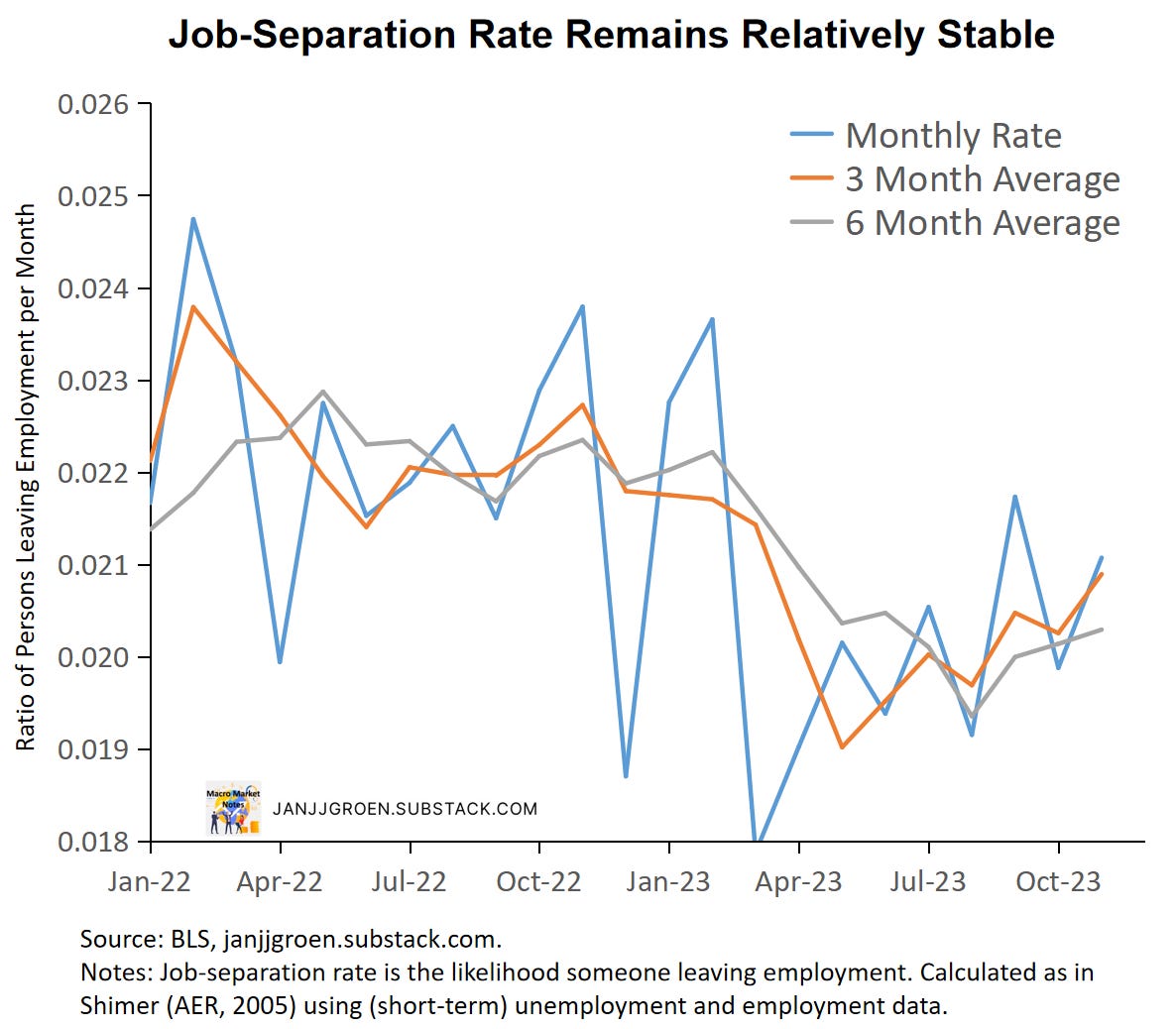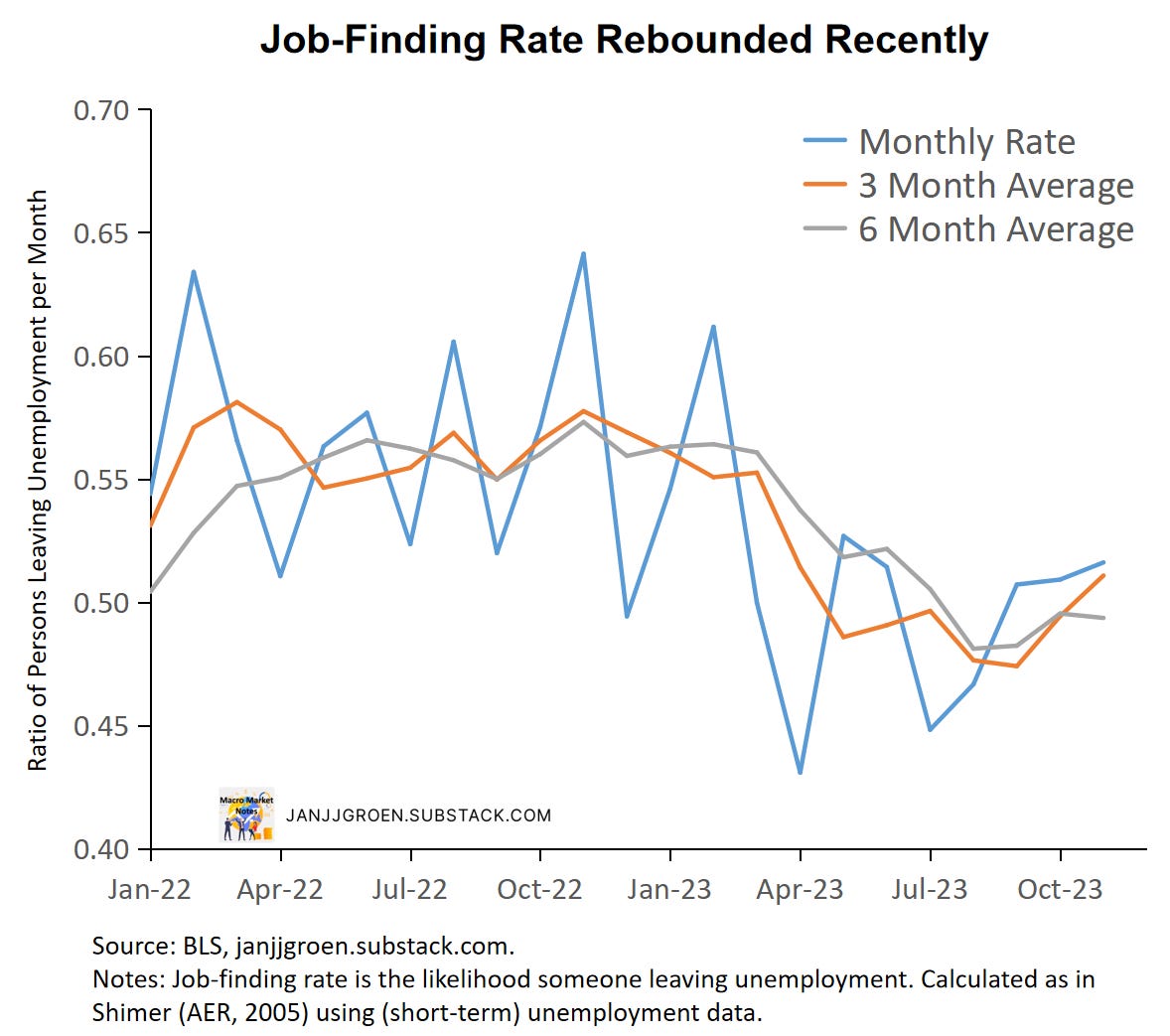Dec Payrolls: Another Month, Another Sturdy Jobs Report
The decline in the labor force in December and a higher job-finding rate suggests the labor market will remain solid. The Fed will be patient with rate cuts.
Today’s December Employment Situation report as well as the minutes from the December FOMC meeting earlier this week garnered a lot of attention. The labor market data signaled continued strength in the U.S. economy including firming wage growth, which will keep the Fed on hold in terms of its policy stance.
Key takeaways:
Payrolls growth momentum remains firm and continues to run above the breakeven pace needed to keep the unemployment rate constant.
After slowing earlier in the year, the job-finding rate has been moving up since the summer.
Job-finding odds will likely improve further as the size of the labor force shrank and can be expected to grow more moderately going forward.
Wage growth firmed and outpaced the medium-run rate that is consistent with 2% inflation.
Combined with an expected year-ahead real interest rate that has passed its peak, today’s data means the Fed will be in no hurry to cut rates.
December Jobs Growth: Keep on Goin’
The December jobs report released today suggests the U.S. labor market remained sturdy. Payrolls in the establishment survey were up by 216,000 persons in December, up from a 173,000 increase in the preceding month (which was downwardly revised from 199,000). The breadth of payrolls growth remains somewhat limited with the main drivers being the construction sector (+17k in Dec. from +6k in Nov.) as well as the education and health services (+74k in Dec. from +109k in Nov.) and government (+52k in Dec. from +37k in Nov.) sectors. Compared to November, however, breadth did improve with major jobs growth improvements in the retail trade (+17.4k in Dec. from -24.4k in Nov.) and professional/business services (+13k in Dec. from -19k in Nov.). As such both the one-month and three-month diffusion indices of payrolls growth across sectors went up from 56.6 and 58.6, respectively, in November to 59.6 and 61.8.1
The unemployment rate remained unchanged at 3.7% in December, as the household employment growth plunged relative to November: from +586,000 persons in November to -683,000 persons. Meanwhile, the labor force shrank with a similar amount in December: 676,000 persons, suggesting that most people who left their job in December did so to leave the labor force altogether. The chart above compares the job growth signals from the establishment and household surveys, and it shows the excess volatility of the household survey relative to the establishment survey, with the former mean-reverting back to the latter after a big move in either direction. This likely reflects the relatively smaller sample size of the household survey as well as the large moves in the labor force over the past two years.
The moves in household employment and labor force meant that the labor force participation rate dropped from 62.8% to 62.5% in December. Leading up to December the labor force participation rate had been broadly stable around 62.8% since August, well above the longer-term trend as estimated, e.g., by the CBO, so this decline might be a tentative sign of reversal back to trend.
Moving beyond the month-to-month movements, the chart above shows three- and six-month moving averages of payrolls changes from the establishment survey since January 2022. The underlying pace of job creation in the U.S. economy has been slowing throughout 2023, with the deceleration intensifying between April and August. However, since August the pace of deceleration has leveled off somewhat. Given today’s data on unemployment and labor force participation, the smoothed trends in payrolls growth continue to be above the breakeven pace needed to keep the unemployment rate around 3.7% over the next 6 months (purple dashed line in the above chart).
Similar conclusions can be drawn from the household employment survey. Following Shimer (AER, 2005), we can use data on total unemployed and employed persons as well as the number of people that are unemployed for less than 5 weeks to estimate:
Job-finding rate: the probability an unemployed person in month t will find a job or leaves the labor force. This is calculated assuming that total unemployment in month t+1 equals month t unemployment plus the number of people unemployed for less than 5 weeks in month t+1.2
Job-separation rate: the probability an employed person in month t will either loses its job, quits or retires, which depends on data on the job-finding rate, unemployment and employment.3
The chart above plot for the most recent period the estimated job-separation. The job-separation rate has been relatively stable over the period, with a moderate downward shift in the first half of 2023 that stabilized between June and October. With lay-offs and quits remaining stable over this period this likely reflected an increase in the labor force owing to a rebound in the foreign-born labor force. Conversely with still minimal moves in lay-off and quits rates, the more recent tick-up in separation rates reflects the reversal in labor force growth signified in the December household survey. Note, however, that the chart above also makes clear that the variability in the separation rate has been relatively modest.
More pronounced moves can be observed for the estimated job-finding rate (chart above). The job-finding rate fell off markedly after March and fell from a probability a person no longer is unemployed in a given month equal to around 55% in early 2023 to close to 45% by the summer. Given the earlier discussed decline in job-separation rate over the same period, this likely reflected a significant decline in hiring by firms as the supply of workers increased. However, since the summer the job-finding rate recovered and bounced back towards a probability of around 50% that a person leaves unemployment in a given month.
The total number of unemployed persons remained essentially unchanged in December, but the number of people unemployed less than five weeks increased. Given that the December decline in household employment was almost entirely due to a decline in the labor force, this meant about 52% of the people who were already unemployed in November (see blue line in the chart above) were able to find a job in December. With a more tempered labor force growth going forward, the higher job-finding rate likely will keep the labor market on a solid footing in the near term.
Accelerating Wage Growth
Finally, what did this job report’s data reveal about wage growth? As in the preceding month, average hourly earnings grew over the month in December by 0.4% month/month and ticked up in year/year terms from 4% in November to 4.1%. The wage data from the jobs report are notoriously noisy, given that they are revised often and do not correct for the sectoral and skills composition of jobs growth over the month. There are better quality wage data available, such as the Atlanta Fed Wage Growth Tracker and the Employment Cost Index, but the Atlanta Fed does construct a rudimentary composition correction for average hourly earnings from the jobs report, which can be found here.
The chart above chart makes clear that throughout the year composition-corrected average hourly earnings for production and nonsupervisory workers has slowed from the very elevated rates seen in 2022. Since the summer, however, the pace of wage disinflation slowed with momentum petering out in the Fall. In fact, since October wage growth for production and nonsupervisory workers accelerated again.
When I combine labor productivity and labor share trend estimates with the 2% inflation target, along the lines I do in my usual monthly “Wages and Inflation Expectations” note, the December medium-run annual wage growth rate consistent with 2% inflation stands at about 2.6% (purple line in the above chart). Throughout 2023 wage growth has remained above this benchmark despite slowing, and now has started to move away from it again. The Fed will need to see more progress on wage growth for it to be confident that in particular core services excl. housing PCE inflation will eventually slow enough to move overall core PCE inflation on a sustained path back to 2%.
A Patient Fed
Earlier this week the minutes for the December FOMC meeting were released. In terms of the expected interest rate policy for 2024, the tone of the minutes really revealed a Fed that is willing to be patient to assess the sustainability of the disinflation that has occurred. Therefore, the recent easing in spot inflation data should not be seen as a sign that rate cuts are already forthcoming in Q1 of 2024. Fed officials are utilizing more of a forward-looking view, based on the expected path of inflation for the year ahead.
The December SEP projections showed that the expected real rate path really did not change that much compared to earlier meetings. Furthermore, perceived inflation survey-based year-ahead real rates have actually eased somewhat (chart above). In combination with a still robust labor market and consumption spending, this means that the Fed can afford to be patient in determining the start date of maintenance cuts to further assess whether inflation is indeed easing along a medium-term path back to 2%. My modal view, therefore, remains that we are not going to see a move toward policy rate cuts before mid-2024.
50 indicates an equal balance between industries with increasing and decreasing employment.
Given this calculation, the job-finding rate will run up to October utilizing data on (short-term) unemployment for November.
As the calculation of the job-separation rate depends also on (short-term) unemployment for November, we cannot go beyond October.







